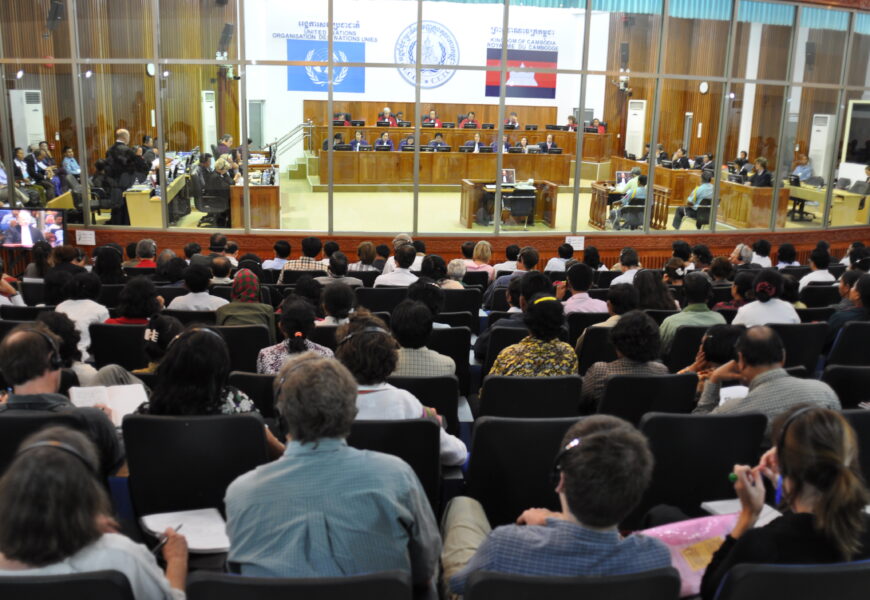RUDINA JASINI
Justice for victims has often been claimed as the raison d’être and the rallying call of international criminal justice mechanisms. This noble goal has been at the heart of the work of hybrid and ad hoc international criminal tribunals as well as the International Criminal Court (ICC). The recognition of victims’ participatory rights in criminal proceedings is a novelty in international criminal law.[1] As such, the incorporation of victims as civil parties (partie civile) in international criminal proceedings has marked a significant advance for victims’ rights. This development is the product of a broad movement and parallel advancements in both domestic and international legal systems towards greater acknowledgment of victims’ rights. It was a response to the growing criticism by victims’ rights advocates and organisations that concerned the apparent marginalisation of victims within the criminal justice process.[2] The pronounced trend towards enhancing victim participation at the international level was reflected in the efforts made by the ICC, established under the Rome Statute, which became the first international criminal tribunal to endorse active victim participation by recognising victims as ‘participants’. This new dimension of victims’ rights was further heightened at the Extraordinary Chambers in the Courts of Cambodia (ECCC), mainly by offering an unprecedented characterisation of victims as full ‘parties’ to rather than just ‘participants’ in proceedings. This trend has been reflected also in the Special Tribunal for Lebanon (STL) and the newly established Kosovo’s Specialist Chambers (Kosovo’s special crimes court) in The Hague. This development and the shift in international criminal law towards greater victim recognition and centrality, mirror to a great extent the growing prominence of restorative justice and the rise of victims’ rights in Western domestic justice systems.[3]
Human Rights Instruments, Institutions and the Advancement of Victims’ Rights
The evolution and strengthening of victims’ rights have found expression in two important international legal instruments: first, in the 1985 United Nations (UN) Declaration of Basic Principles of Justice for Victims of Crime and Abuse of Power (the Victims’ Declaration), with a focus primarily on victims of domestic crimes; and secondly, in the 2006 Basic Principles and Guidelines on the Right to a Remedy and Reparation for Victims of Gross Violations of International Human Rights Law and Serious Violations of International Humanitarian Law (the Basic Principles), which has been described as ‘for all practical purposes, an international bill of rights of victims’,[4] with a principal focus on victims of international crimes. A multitude of measures and advances have contributed to the increasingly prominent role afforded to victims in contemporary international criminal law. These developments were triggered and influenced by numerous factors, in particular the Basic Principles, the expansion of victims’ rights under international human rights and humanitarian law, coupled with increasing recognition of victims’ rights in the jurisprudence of the European Court of Human Rights (ECtHR) and the Inter-American Court of Human Rights (IACtHR). The establishment of various diverse ad hoc and hybrid tribunals, and subsequently of the ICC, have made further important contributions to progress in this area, leading to enhanced procedural, substantive and remedial rights for victims. This is apparent in the greater rights afforded to victims in the context of court proceedings, including inter alia disclosure of documents, victim protection, and the availability of remedies, in particular reparations.
Typologies of Victim Participation in the Criminal Justice Process
There are five main typologies of victim participation.[5] The most basic form of participation granted by all legal systems is that of complainant: the victim makes an official complaint to the police or other judicial or prosecutorial state institution, thereby triggering a criminal investigation and, potentially, charges against the accused. Secondly, victim-complainants often also fulfil the role of victim-witnesses, in particular during the pre-trial and trial stages of proceedings. A third type of victim participation is that of private or auxiliary prosecutor. Indeed, most civil law jurisdictions permit private prosecutions for minor crimes, and recognise ‘auxiliary prosecutors’, whose role is attached to that of a public prosecutor.[6] In most common law systems such as the United Kingdom, the United States and Australia, crimes were traditionally regarded as being offences against the state or the Crown as much as against the victim himself, and the right to act as a private prosecutor survives in those jurisdictions. The right to bring private prosecutions is most prevalent in England and Wales.
A more recent development has, fourthly, been impact statements provided by victims, known as the Victim Personal Statement. This type of statement has become common in particular in common law countries, the first such statement being introduced in California in 1976.[7] Such statements were introduced in New Zealand in 1987, in Canada in 1988, and rolled out nationally across England and Wales in 2001. This allows victims to submit a formal statement to be read out in open court, testifying to the victims’ personal, physical, emotional, and financial trauma and suffering. Some jurisdictions go further and allow victims to make observations related to sentencing in their impact statements.[8]
Finally, a more enhanced and somewhat different form of participation is civil party participation, with which this article is concerned. The participation of victims as civil party or partie civile in criminal proceedings finds its genesis in French law and other civil law jurisdictions, although the precise parameters of civil party participation vary from one system to another; it is, however, unknown to most common law systems. Unlike witnesses, civil parties do not give evidence or testimony under oath.[9] Subject to exceptions, they generally have similar rights as other parties to proceedings, including the right to question the accused and to make closing submissions. The participation of a victim as a civil party must however pertain to a specific claim for damages.[10]
Civil Party Participation and Its Application in Practice
In a landscape of evolving jurisprudential and academic discourse on victim participation as well as practice in international criminal trials, the incorporation of victim participation as a restorative justice element into an inherently retributive justice process, has brought into sharper focus the need for a more critical and comprehensive normative and empirical examination of victim participation as both an approach and a principle. The seemingly innovative approach endorsed by the ICC, the ECCC and other tribunals, by including victims of alleged crimes as civil parties, rather than as mere witnesses, offering an unprecedented expansion of victims’ rights, has revealed potential strengths and weaknesses as well as the possibilities for the future direction of development in international criminal justice. There has been a significant shift on the domestic and international planes where the focus is no longer solely on retribution or the utility of punishment, but also on restorative principles. This development has led to enhanced service and procedural rights for victims, and to greater recognition of the harm suffered. However, given the nature of international criminal trials including subject-matter limitations, the structure and composition of international criminal tribunals, as well as the magnitude of cases and the nature of mass victimisation – distinguishing them in many significant ways from domestic criminal proceedings – victim participation in international criminal proceedings has posed some unique and specific questions and themes, which in turn have given rise to complex answers and challenges.
A Balancing Act: Civil Party Participation and Equality of Arms
In spite of this noteworthy development, the complex civil party process has not been without challenges. One of the most evident procedural issues arising out of participation has been the frequent criticism that this ‘impedes the equilibrium between prosecution and defence’[11] and that it impinges upon the right of the accused to a fair and expeditious trial. My research on civil party participation at the ECCC in Cambodia, has demonstrated that civil party participation has had a bearing on equality of arms and the functionality of trial proceedings. Furthermore, the outcome of trial proceedings has also led to questions about the assumption that expansive participation in criminal proceedings furthers victims’ interests. The application of the complex civil party participation scheme at the ECCC has also raised, from a legal and procedural standpoint, some important questions regarding the intended and unintended effects on civil parties and victims.
Prolongation of Court Proceedings
One major challenge posed by civil party participation relates to the impact that civil party participation has had on the prolongation of trial proceedings, thus increasing the cost of trials. A requirement of first principle in any criminal trial is the protection of the defendant’s right to a fair and expeditious trial.
Effects on Prosecution and Defence
The implications of and the costs created by victim participation for the prosecution and defence have brought into sharper focus the need for the ECCC and other international criminal tribunals to shape victim participation so as best to accommodate competing interests. One of the fundamental principles upon which the ECCC and all other international criminal tribunals function is that proceedings shall be fair and adversarial and preserve a balance between the rights of the parties. At the ECCC trials, civil party participation often became a trial management issue, prompting the Chamber (judges) to impose a system of time limits on all the parties as a response to concerns over the slow pace of the proceedings. The defence often objected to the time allocated to them, arguing that they faced ‘two prosecutors’ and expected to respond to a barrage of motions by the civil parties, and that the imbalance amounted to a violation of the rights of the defendant. Another remarkable angle, which is not instinctively apparent, is that civil party participation can have a bearing not only on the defence, but also on the prosecution’s job, often resulting in continuous tension over inconsistencies that range from theories of criminal responsibility to questionable evidence and so forth.
While acknowledging that efforts to enhance victims’ rights can lead, at least in theory, to the realisation of the aspiration of restorative justice for victims, a practical evaluation demands a careful consideration of the often unquestioned assumption that expanded participation is in the victims’ best interests. There are two dimensions to the effects of victim participation; first in respect of victims recognised as civil parties, and second in respect of un-recognised victims. With regards to the former, the victim is required to choose quite early on in the proceedings whether he or she wants to participate as a witness or as a civil party. Therefore participating victims may be denied the opportunity to testify under oath as witnesses, which on the other hand affects the prosecution’s opportunity to present information that could further assist in incriminating the accused.[12] By contrast, civil party testimony is not given under oath, and it should therefore carry less weight than witness evidence, especially since civil parties, unlike witnesses, attend all closed and public hearings before testimony, which could have an impact on the information that they provide. With regard to the second dimension, compared to approximately 1.7 million people who perished under the Khmer Rouge in Cambodia, victims recognised as civil parties by the ECCC represent only a fraction of the overall number of direct and indirect victims. In determining the role and impact of victim participation at the ECCC, one should be cautious about the effects that such participation could have on victims who are not granted permission by the Court to take part in the proceedings. Granting permission to some victims at the exclusion of others could potentially bring about unintended and undesirable consequences, especially in light of the quest for national reconciliation and victims’ aspirations to unearth the truth, both key objectives of any international criminal tribunal.
A Promising Route Forward?
What emerges from the way in which victim participation has been crafted and applied so far at the ECCC, the ICC and other international criminal tribunals, is the understanding that despite victim involvement being a salient feature of the process, the trials have appeared more as ‘experimenting laboratories’ than as processes guided by sound and well-crafted rules and procedures. The incorporation of victim participation as a restorative justice element into an inherently retributive justice process is in its nascent stage in international criminal justice and the inclusion of various provisions relating to victims’ rights within international criminal tribunals has in principle broadened the scope of procedural and substantive rights afforded to victims. However, my research on the civil party participation regime has found that the incorporation of victims as civil parties into proceedings raises significant questions and gives rise to a number of challenges inherent in the tension between an increase in the rights afforded to victims on the one hand, and the established due process rights available to the defence on the other. Five key findings have emerged:
First, whilst victims have taken advantage of their procedural rights, their role remains largely symbolic and they have yet in full to realise their substantive rights. Evidently there is a disconnect between victims’ expectations and practice on the ground, and the tribunals’ shortcomings stand in stark contrast to victims’ high expectations in relation to reparations. Although symbolic justice for victims may be the current approach at the ECCC, the ICC as well as other international criminal tribunals that have afforded victims greater participatory rights, it is important that these tribunals take the necessary measures to overcome jurisdictional and structural limitations inherent in their reparations mandate in order to move beyond rhetoric by delivering more meaningful justice to victims of international crimes.
Second, if international criminal tribunals afford victims the right to participate in proceedings, it is imperative that they develop a sound statutory and procedural foundation with clear and detailed rules and procedures from the outset. Legislation needs to clearly specify the rights of victims recognised as civil parties and the responsibilities of the criminal justice system and the court’s personnel regarding victims.
Third, the implications of the civil party participation scheme suggest that any effort to valorise expanded participatory rights by affording victims a role beyond that of complainant or witness demands first of all careful consideration of whether increased participation is in the best interests of victims and of justice more generally. We need to develop a realistic understanding of the potential shortcomings that civil party participation could have with regards to the vital objectives of fairness, functionality of court proceedings, and victims’ needs and interests.
Fourth, what emerged from the manner in which civil party participation has been dealt with by the ECCC and other tribunals, is that members of the court, including judges, legal officers, prosecutors, defence lawyers, and victims’ legal representatives, all seemed to be caught ‘off guard’ by this recent development, and not fully prepared to implement such a novel mechanism. It is, therefore, important to have a knowledgeable and supportive criminal justice community. Victims’ views, insights and experiences are guided by the information provided to them, as well as by the way their requests are received by the Court. Giving due consideration to victims’ interests and needs in this regard is crucial.
Finally, victim participation is still in its nascent stage on the international scene, and its application in practice is therefore quite fluid, and at times vague and contradictory. There is a critical need for well-developed common standards, at both a legal and normative level, to guide the application of victim participation in practice. Ultimately, recognising victims’ rights to equal and effective access to justice, providing protection and support as well as adequate and prompt reparation for harm suffered demands a comprehensive and integrated approach, something that courts are not best placed to achieve on their own.
Dr. Rudina Jasini is a lecturer and a researcher at the Faculty of Law, University of Oxford, specialising in international criminal law and human rights law. Prior to her time at Oxford, Rudina worked as an attorney for the UN International Criminal Tribunal for the former Yugoslavia (ICTY) in The Hague. She has also worked with the legal team providing representation and assistance to victims of the Khmer Rouge regime in Cambodia.
Bibliography
Ashworth, Andrew. ‘Victim Impact Statements and Sentencing.’ Criminal Law Review 498; 1993.
Bassiouni, M. Cherif. ‘International Recognition of Victim’s Rights.’ 6 Human Rights Law Review 203; 2006
Baumgartner, Elisabeth. ‘Aspects of Victim Participation in the Proceedings of the International Criminal Court.’ International Review of the Red Cross 432. 90(870). 2008
Brienen Marion E. and Hoegen, Ernestine H. Victims of Crime in “European Criminal Justice Systems: The Implementation of Recommendation” (85) 11 of the Council of Europe on the Position of the Victim in the Framework of Criminal Law and Procedure (Wolf Legal Publishers 2000).
Hoyle, Carolyn. ‘Victims, the Criminal Process, and Restorative Justice’ in Mike Maguire, Rod Morgan and Robert Reiner (eds), The Oxford Handbook of Criminology (5th edn Oxford University Press 2012) 398.
Manikis, Marie and Roberts, Julian V.. ‘Victim Personal Statements: Latest (and Last) Trends from the Witnesses and Victims Experience Survey in England and Wales’ 13:3 Criminology and Criminal Justice 245, 246. 2013.
McGonigle Leyh, Brianne. “Procedural Justice? Victim Participation in International Criminal Proceedings” (Intersentia 2011) 78-86.
Schabas, William A. “An Introduction to the International Criminal Court.” 2nd edn Cambridge University Press 2004. See also Emily Haslam, ‘Victim Participation at the International Criminal Court: A Triumph of Hope Over Experience?’ in Dominic McGoldrick, Peter Rowe and Eric Donnelly (eds), The Permanent International Criminal Court: Legal Policy and Issues (Hart Publishing 2004) 315.
Sheehan, Albert V. Criminal Procedure in Scotland and France (Her Majesty’s Stationary Office). 1975
Trumbull, Charles P. ‘The Victims of Victim Participation in International Criminal Proceedings’. Michigan Journal of International Law 777, 810. 2008.
van Dijk, Jan. ‘Victim Rights: A Right to Better Services or a Right to Active Participation?’ in Jan van Dijk, Charles Haffmans et al. (eds), Criminal Law in Action. Kluwer Law International, 1998.
Zedner,
Lucia. Criminal Justice, Clarendon
Law Series. Oxford University Press, 2004.
[1] William A. Schabas, An Introduction to the International Criminal Court (2nd edn Cambridge University Press 2004) 328; Antonio Cassese, ‘The Statute of the International Criminal Court: Some Preliminary Reflections’ (1999) 10 European Journal of International Law 144, 167; See also Emily Haslam, ‘Victim Participation at the International Criminal Court: A Triumph of Hope Over Experience?’in Dominic McGoldrick, Peter Rowe and Eric Donnelly (eds), The Permanent International Criminal Court: Legal Policy and Issues (Hart Publishing 2004) 315.
[2] Lucia Zedner, Criminal Justice, Clarendon Law Series (Oxford University Press 2004) 143.
[3] Carolyn Hoyle, ‘Victims, the Criminal Process, and Restorative Justice’ in Mike Maguire, Rod Morgan and Robert Reiner (eds), The Oxford Handbook of Criminology (5th edn Oxford University Press 2012) 398.
[4] M. Cherif Bassiouni, ‘International Recognition of Victim’s Rights’ (2006) 6 Human Rights Law Review 203.
[5] Brianne McGonigle Leyh, Procedural Justice? Victim Participation in International Criminal Proceedings (Intersentia 2011) 78-86.
[6] Marion E. Brienen and Ernestine H. Hoegen, Victims of Crime in 22 European Criminal Justice Systems: The Implementation of Recommendation (85) 11 of the Council of Europe on the Position of the Victim in the Framework of Criminal Law and Procedure (Wolf Legal Publishers 2000).
[7] Marie Manikis and Julian V. Roberts, ‘Victim Personal Statements: Latest (and Last) Trends from the Witnesses and Victims Experience Survey in England and Wales’ (2013) 13:3 Criminology and Criminal Justice 245, 246.
[8] See generally Andrew Ashworth, ‘Victim Impact Statements and Sentencing’ (1993) Criminal Law Review 498.
[9] Albert V. Sheehan, Criminal Procedure in Scotland and France (Her Majesty’s Stationary Office 1975) 22.
[10] Jan van Dijk, ‘Victim Rights: A Right to Better Services or a Right to Active Participation?’ in Jan van Dijk, Charles Haffmans et al. (eds), Criminal Law in Action (Kluwer Law International 1988) 351.
[11] Elisabeth Baumgartner, ‘Aspects of Victim Participation in the Proceedings of the International Criminal Court’ (2008) 90(870) International Review of the Red Cross 432.
[12] Charles P. Trumbull, ‘The Victims of Victim Participation in International Criminal Proceedings’(2008) 29 Michigan Journal of International Law 777, 810.










